Abnormal kinetochore-generated pulling forces from expressing a N-terminally modified Hec1
- PMID: 21297979
- PMCID: PMC3030568
- DOI: 10.1371/journal.pone.0016307
Abnormal kinetochore-generated pulling forces from expressing a N-terminally modified Hec1
Abstract
Background: Highly Expressed in Cancer protein 1 (Hec1) is a constituent of the Ndc80 complex, a kinetochore component that has been shown to have a fundamental role in stable kinetochore-microtubule attachment, chromosome alignment and spindle checkpoint activation at mitosis. HEC1 RNA is found up-regulated in several cancer cells, suggesting a role for HEC1 deregulation in cancer. In light of this, we have investigated the consequences of experimentally-driven Hec1 expression on mitosis and chromosome segregation in an inducible expression system from human cells.
Methodology/principal findings: Overexpression of Hec1 could never be obtained in HeLa clones inducibly expressing C-terminally tagged Hec1 or untagged Hec1, suggesting that Hec1 cellular levels are tightly controlled. On the contrary, a chimeric protein with an EGFP tag fused to the Hec1 N-terminus accumulated in cells and disrupted mitotic division. EGFP- Hec1 cells underwent altered chromosome segregation within multipolar spindles that originated from centriole splitting. We found that EGFP-Hec1 assembled a mutant Ndc80 complex that was unable to rescue the mitotic phenotypes of Hec1 depletion. Kinetochores harboring EGFP-Hec1 formed persisting lateral microtubule-kinetochore interactions that recruited the plus-end depolymerase MCAK and the microtubule stabilizing protein HURP on K-fibers. In these conditions the plus-end kinesin CENP-E was preferentially retained at kinetochores. RNAi-mediated CENP-E depletion further demonstrated that CENP-E function was required for multipolar spindle formation in EGFP-Hec1 expressing cells.
Conclusions/significance: Our study suggests that modifications on Hec1 N-terminal tail can alter kinetochore-microtubule attachment stability and influence Ndc80 complex function independently from the intracellular levels of the protein. N-terminally modified Hec1 promotes spindle pole fragmentation by CENP-E-mediated plus-end directed kinetochore pulling forces that disrupt the fine balance of kinetochore- and centrosome-associated forces regulating spindle bipolarity. Overall, our findings support a model in which centrosome integrity is influenced by the pathways regulating kinetochore-microtubule attachment stability.
Conflict of interest statement
Figures

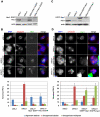

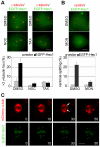

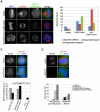
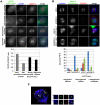
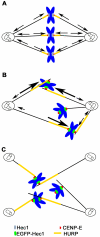
Similar articles
-
CENP-W plays a role in maintaining bipolar spindle structure.PLoS One. 2014 Oct 15;9(10):e106464. doi: 10.1371/journal.pone.0106464. eCollection 2014. PLoS One. 2014. PMID: 25329824 Free PMC article.
-
N-terminus-modified Hec1 suppresses tumour growth by interfering with kinetochore-microtubule dynamics.Oncogene. 2015 Jun;34(25):3325-35. doi: 10.1038/onc.2014.265. Epub 2014 Aug 18. Oncogene. 2015. PMID: 25132262
-
Dynamic acetylation of the kinetochore-associated protein HEC1 ensures accurate microtubule-kinetochore attachment.J Biol Chem. 2019 Jan 11;294(2):576-592. doi: 10.1074/jbc.RA118.003844. Epub 2018 Nov 8. J Biol Chem. 2019. PMID: 30409912 Free PMC article.
-
Leaving no-one behind: how CENP-E facilitates chromosome alignment.Essays Biochem. 2020 Sep 4;64(2):313-324. doi: 10.1042/EBC20190073. Essays Biochem. 2020. PMID: 32347304 Free PMC article. Review.
-
Hec1/Ndc80 Tail Domain Function at the Kinetochore-Microtubule Interface.Front Cell Dev Biol. 2020 Feb 26;8:43. doi: 10.3389/fcell.2020.00043. eCollection 2020. Front Cell Dev Biol. 2020. PMID: 32161753 Free PMC article. Review.
Cited by
-
CENP-W plays a role in maintaining bipolar spindle structure.PLoS One. 2014 Oct 15;9(10):e106464. doi: 10.1371/journal.pone.0106464. eCollection 2014. PLoS One. 2014. PMID: 25329824 Free PMC article.
-
Kinetochore-microtube attachments in cancer therapy.Oncoscience. 2015 Nov 16;2(11):902-3. doi: 10.18632/oncoscience.265. eCollection 2015. Oncoscience. 2015. PMID: 26697517 Free PMC article. No abstract available.
-
Dynein light intermediate chains maintain spindle bipolarity by functioning in centriole cohesion.J Cell Biol. 2014 Nov 24;207(4):499-516. doi: 10.1083/jcb.201408025. J Cell Biol. 2014. PMID: 25422374 Free PMC article.
-
RBBP4 regulates histone deacetylation and bipolar spindle assembly during oocyte maturation in the mouse.Biol Reprod. 2015 Apr;92(4):105. doi: 10.1095/biolreprod.115.128298. Epub 2015 Mar 18. Biol Reprod. 2015. PMID: 25788661 Free PMC article.
-
Effect of NDC80 in human hepatocellular carcinoma.World J Gastroenterol. 2017 May 28;23(20):3675-3683. doi: 10.3748/wjg.v23.i20.3675. World J Gastroenterol. 2017. PMID: 28611520 Free PMC article.
References
-
- Cheeseman IM, Desai A. Molecular architecture of the kinetochore-microtubule interface. Nat Rev Mol Cell Biol. 2008;9:33–46. - PubMed
-
- Musacchio A, Salmon ED. The spindle-assembly checkpoint in space and time. Nat Rev Mol Cell Biol. 2007;8:379–393. - PubMed
-
- Kops GJ, Weaver BA, Cleveland DW. On the road to cancer: aneuploidy and the mitotic checkpoint. Nat Rev Cancer. 2005;5:773–785. - PubMed
-
- Cimini D, Degrassi F. Aneuploidy: a matter of bad connections. Trends Cell Biol. 2005;15:442–451. - PubMed
Publication types
MeSH terms
Substances
LinkOut - more resources
Full Text Sources
Research Materials

